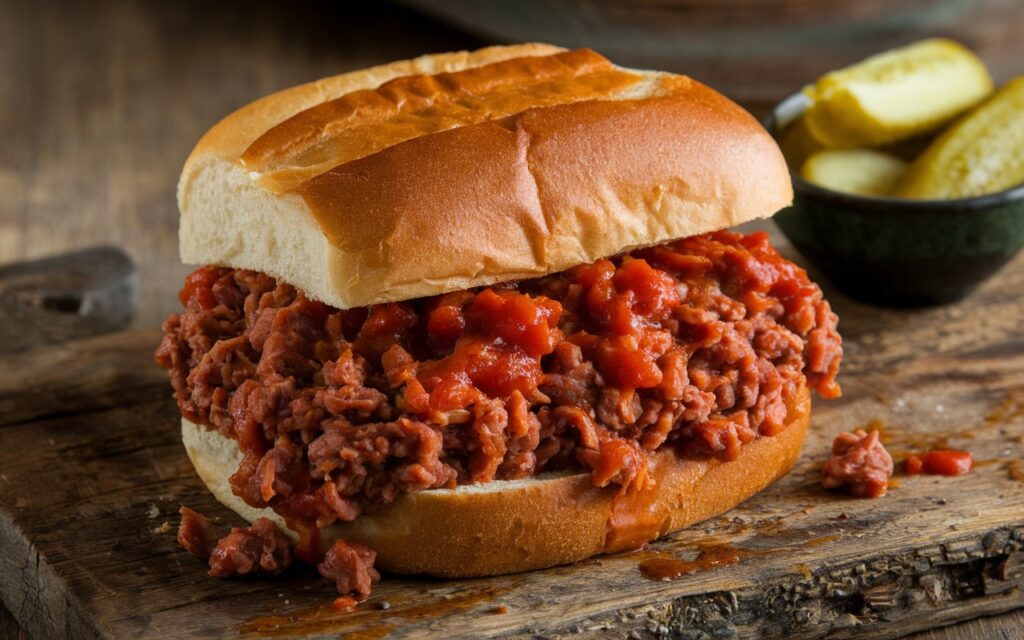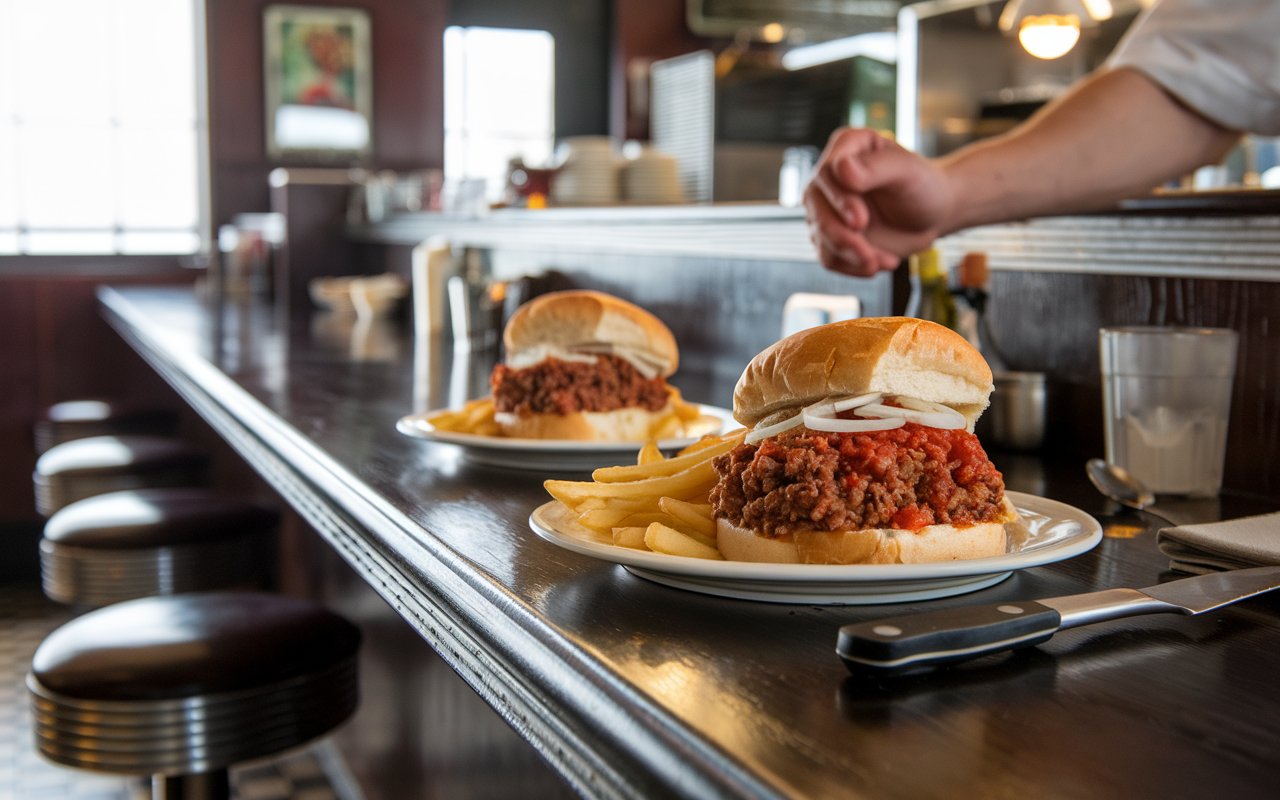The Sloppy Joe sandwich is a quintessential comfort food, beloved for its rich, savory flavors and messy, fun-to-eat appeal. This iconic dish has become a staple in American households and diners, cherished for its simplicity and adaptability. But like many culinary classics, the origins of the Sloppy Joe are shrouded in mystery, and its ingredients have evolved over time. Exploring the roots of this timeless sandwich sheds light on its enduring popularity and the humble beginnings that made it a favorite across generations.
The original Sloppy Joe is a culinary journey, showing how simple, budget-friendly ingredients create unforgettable flavors. At its heart, the Sloppy Joe captures the essence of comfort food: hearty, flavorful, and deeply satisfying.
The Origins of the Sloppy Joe
Historical Background
The Sloppy Joe’s story reflects American comfort food’s evolution—defined by simplicity, affordability, and heartiness.
During the early 20th century, economic hardships forced American households to create affordable meals with lasting flavor.
In this setting, the Sloppy Joe emerged—a saucy sandwich with ground beef, seasonings, and tomato-based sauce on a bun.
This dish became a quick, budget-friendly way to feed families, securing its spot in American comfort food history.
Theories About Its Invention
Cuban Bar Origin Story
One popular theory suggests that the Sloppy Joe traces its origins to Havana, Cuba, at a bar owned by José García. The dish became famous among American tourists in the Prohibition era, and returning travelers reportedly brought the concept back to the U.S., inspiring its adaptation into the version we know today.
Midwestern Diner Theory
Another prevailing theory points to the Midwest, where diners were experimenting with ground beef dishes in the 1930s. A cook in Sioux City, Iowa, named Joe is often credited with creating the original Sloppy Joe by adding a tomato-based sauce to loose meat sandwiches. This simple innovation turned a dry sandwich into a flavorful and saucy meal, quickly earning its place on diner menus and in home kitchens across the country.
Connection to Early Loose Meat Sandwiches
Before the Sloppy Joe, loose meat sandwiches were already popular, especially in the Midwest. These sandwiches lacked the distinctive tomato-based sauce that defines the modern Sloppy Joe. Adding onions, ketchup, and Worcestershire sauce transformed loose meat sandwiches into today’s messy, saucy delight.
The Sloppy Joe’s story highlights adaptability and culinary ingenuity during tough times. Cooks made the most of available ingredients.
Key Ingredients in the Original Sloppy Joe
The Essential Base – Ground Beef
At the heart of the original Sloppy Joe is ground beef, a staple ingredient in American cooking during the early 20th century. Ground beef was not only widely available but also affordable, making it a logical choice for home cooks and diner chefs looking to create hearty meals on a budget. Its versatility and ability to absorb flavors made it the perfect base for the saucy, flavorful Sloppy Joe.
During the Great Depression, the affordability of ground beef played a significant role in its inclusion in recipes. Families stretched small amounts of beef with sauces. Serving it over bread created filling meals for large groups. This practicality, combined with its satisfying taste and texture, cemented ground beef as the essential base of the Sloppy Joe.
The Sauce – A Tangy Tomato Mixture
The defining feature of the Sloppy Joe is its tangy, tomato-based sauce. Early recipes often relied on simple, pantry-friendly ingredients like ketchup or canned tomato sauce to create this signature mixture. Sweet and acidic ingredients enhanced the beef’s flavor while keeping the recipe simple and affordable.
To achieve a sweet and tangy profile, many early Sloppy Joe recipes included sweeteners such as sugar, molasses, or brown sugar. These added a hint of sweetness that complemented the savory meat and tangy tomato sauce, creating a flavor combination that was both bold and comforting.
The Bind – Worcestershire Sauce and Spices
Worcestershire sauce played a crucial role in the original Sloppy Joe, acting as a flavor enhancer that added depth and complexity. Its blend of savory, tangy, and slightly sweet notes elevated the dish, turning a simple meat mixture into something truly memorable.
Common spices like garlic powder, paprika, and mustard added flavor. Chili powder sometimes provided an extra kick. These spices provided a subtle kick and rounded out the sauce’s profile, making the dish more robust and satisfying. This combination of Worcestershire sauce and spices became a hallmark of the Sloppy Joe’s distinctive taste.
Bread – The Carrier of Flavors
No Sloppy Joe is complete without the right bread to hold its saucy, messy mixture. Soft hamburger buns were perfect for Sloppy Joes. They soaked up the sauce while staying easy to eat.
Bread served a practical purpose as well, acting as a “carrier” that made the Sloppy Joe portable and more filling. Its softness allowed it to absorb the sauce without overwhelming the flavor of the meat, creating the perfect balance between the sandwich’s components. The role of bread in early Sloppy Joes was essential, as it not only complemented the dish but also defined its messy, yet enjoyable eating experience.
Variations of the Original Recipe
Regional Twists
Over time, the Sloppy Joe has evolved to reflect regional preferences and local ingredients, resulting in numerous variations of the original recipe. One common twist involves the addition of vegetables like onions, green peppers, or celery, which enhance the texture and flavor of the dish. These additions not only provide extra nutrients but also add a satisfying crunch that complements the tender ground beef and saucy mixture.
Comparison to Similar Dishes
Loose Meat Sandwiches vs. Sloppy Joes
While the Sloppy Joe is often confused with loose meat sandwiches, the two dishes have distinct differences. Loose meat sandwiches, popularized in the Midwest, consist of seasoned ground beef served on a bun without a tomato-based sauce. Loose meat sandwiches are drier. They rely on the meat’s natural juices and garnishes like mustard or pickles.
In contrast, the Sloppy Joe is defined by its rich, saucy coating, which combines tomato sauce or ketchup with seasonings and sweeteners. This key difference makes the Sloppy Joe messier to eat but also more flavorful and satisfying for those who enjoy a saucy, bold taste.
Global Counterparts
The concept of a ground beef sandwich is not unique to the United States. Across the globe, similar dishes showcase different cultural takes on this comforting classic. For example, in the United Kingdom, “minced beef” sandwiches share some similarities with Sloppy Joes but are often served on crusty bread and seasoned more simply, relying on salt and pepper rather than a complex sauce.
The Sloppy Joe inspired regional and global variations. These adaptations honor its messy roots while exploring new possibilities.
The Role of the Sloppy Joe in American Food Culture
Economic Factors
The Sloppy Joe holds a special place in American food culture, thanks in large part to its origins during the Great Depression.
This era of economic hardship forced families and food establishments to innovate with inexpensive ingredients that could stretch to feed larger groups.
Ground beef, with its affordability and availability, became a go-to protein source, and the Sloppy Joe emerged as a creative solution to transform this humble ingredient into a flavorful, satisfying meal.
This practicality ensured that the dish became a staple in American households, embodying the resourcefulness and resilience of Depression-era cooking.
Popularity in School Lunches
The Sloppy Joe’s adaptability and crowd-pleasing nature soon found it a permanent place in American school lunch programs. By the mid-20th century, the dish had become a popular menu item in school cafeterias across the country. Its affordability, ease of preparation, and ability to serve large groups made it an ideal choice for school cooks.
Over time, the Sloppy Joe was adapted to meet changing nutrition guidelines in schools. Health-conscious adjustments included using leaner ground beef, adding vegetables like diced carrots or bell peppers, and reducing sugar in the sauce.
These modifications aimed to balance the dish’s flavor with its nutritional value, ensuring it could remain a favorite among students while meeting modern dietary standards.
The integration of the Sloppy Joe into school lunch menus not only cemented its status as a comfort food but also introduced it to generations of American children, ensuring its place in the nation’s culinary heritage.
Whether as a homemade meal or a cafeteria staple, the Sloppy Joe continues to evoke nostalgia and reflect the ingenuity of American cooking.
Recipe of the Original Sloppy Joe
A Step-by-Step Guide
Ingredients List for an Authentic Version
To recreate the original Sloppy Joe, you’ll need the following ingredients:
- 1 pound ground beef
- 1 small onion, finely chopped
- 1 green bell pepper, finely chopped (optional)
- 1 cup ketchup or canned tomato sauce
- 1 tablespoon Worcestershire sauce
- 1 tablespoon brown sugar (or molasses)
- 1 teaspoon yellow mustard
- 1/2 teaspoon garlic powder
- Salt and pepper to taste
- 4 soft hamburger buns or sandwich rolls
Simple Preparation Instructions for a Nostalgic Meal
- Cook the Base: In a large skillet over medium heat, cook the ground beef until browned, breaking it apart with a spatula. Drain any excess fat.
- Add Vegetables: Add the chopped onion (and bell pepper, if using) to the skillet. Cook until softened, about 5 minutes.
- Make the Sauce: In a small bowl, combine ketchup or tomato sauce, Worcestershire sauce, brown sugar, mustard, garlic powder, salt, and pepper. Mix well.
- Combine and Simmer: Pour the sauce mixture over the beef and vegetables in the skillet. Stir to coat evenly. Reduce heat to low and simmer for 10–15 minutes, allowing the flavors to meld and the mixture to thicken.
- Serve: Spoon the meat mixture onto hamburger buns or sandwich rolls. Serve hot, with a side of chips, coleslaw, or a pickle for a classic touch.
Tips for Modern-Day Cooking
Substitutions for Healthier Options
- Lean Proteins: Swap ground beef for leaner options like ground turkey or chicken to reduce fat content.
- Low-Sugar Sauce: Use low-sugar ketchup or homemade tomato sauce to cut back on added sugars.
- Whole-Grain Buns: Serve the Sloppy Joe on whole-grain buns for extra fiber and nutrients.
- Add Veggies: Boost the nutritional value by mixing in finely chopped carrots, zucchini, or mushrooms.
Ideas for Customizing the Dish
- Spicy Kick: Add hot sauce, crushed red pepper flakes, or a dash of cayenne for heat.
- Cheesy Twist: Top the Sloppy Joe mixture with a slice of cheddar or provolone cheese before serving.
- Global Flavors: Experiment with seasonings like curry powder, smoked paprika, or soy sauce to give the dish an international flair.
- Plant-Based Version: Use plant-based ground meat or crumbled tofu as a meat alternative while keeping the original sauce intact.
Conclusion
The Sloppy Joe is more than just a sandwich; it’s a slice of American culinary history. Born out of necessity during the Great Depression, this budget-friendly dish turned simple ingredients like ground beef, tomato sauce, and spices into a flavorful, hearty meal that has stood the test of time.
From its mysterious origins in Cuban bars or Midwestern diners to its iconic status in school cafeterias, the Sloppy Joe has become a beloved classic, representing comfort, creativity, and nostalgia.
Its enduring appeal lies in its versatility and the fond memories it evokes for generations who grew up enjoying its messy, saucy goodness.
Whether served in its traditional form or customized to suit modern tastes, the Sloppy Joe invites you to embrace its charm and simplicity.
Try making this iconic dish at home to experience a taste of history and create new memories with your loved ones.

FAQs
Who invented the Sloppy Joe?
The origins of the Sloppy Joe are debated. Some trace it to a Havana bar owned by José García, while others credit a cook named Joe, who added tomato sauce to a loose meat sandwich.
Can Sloppy Joes be made vegetarian or vegan?
Yes! You can substitute ground beef with plant-based alternatives like lentils, crumbled tofu, or store-bought vegan ground meat. The sauce can be kept vegan by using plant-based ketchup and Worcestershire sauce.
How did the Sloppy Joe get its name?
The name likely stems from the sandwich’s messy, “sloppy” appearance due to its saucy filling. It may also reference the cook named Joe, who popularized the dish in Iowa.
What are some creative ways to serve Sloppy Joes today?
- As sliders: Use small buns for bite-sized portions.
- On baked potatoes: Spoon the mixture over a baked potato for a hearty twist.
- In tacos or wraps: Use tortillas instead of buns for a fun variation.
- As a casserole: Layer the mixture with cheese and bake it for a crowd-friendly dish.
- Over pasta: Turn it into a sloppy Joe-inspired spaghetti sauce.
If you’re inspired to try more inventive recipes, don’t miss these cottage cheese breakfast recipes that bring creativity to the table.








